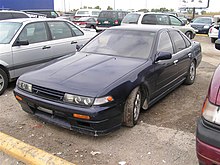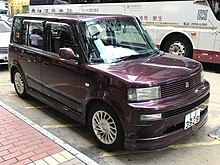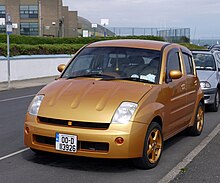How To Make Money Exporting Cars

Japanese used vehicle exporting is a greyness market international merchandise involving the export of used cars and other vehicles from Nippon to other markets around the world since the 1980s.
Despite the high cost of transport, the sale of used cars and other vehicles to other countries is even so assisting due to the relatively low cost and practiced condition of the vehicles beingness purchased. Contributing factors to the feasibility of such export include Japan's strict motor-vehicle inspections and high depreciation which make such vehicles worth very fiddling in Japan later half-dozen years, and strict environmental-protection regulations that make vehicle disposal very expensive in Nihon. Japan has very stringent vehicle emission test standards.[1]
Nearly 1.4 million used vehicles were exported from Nihon in 2006.[ citation needed ] The most popular destinations for used cars from Japan are Australia, People's republic of bangladesh, Barbados, Republic of bolivia, Negara brunei darussalam, Canada, Congo, Dominican Republic, Eswatini, Georgia, Guyana, Hong Kong, Indonesia, Ireland, Jamaica, Republic of kazakhstan, Kenya, Lesotho, Malaysia, Mauritius, Mongolia, Mozambique, Myanmar, New Zealand, Pakistan, Paraguay, Peru, Philippines, Russian federation, Sri Lanka, Suriname, Tanzania, Thailand, Trinidad and Tobago, Republic of uganda, United Kingdom, Zambia, and Zimbabwe. Additionally, Republic of chile, South Africa, Singapore, and the United Arab Emirates are used as popular transit hubs.[ citation needed ]
Overview [edit]
Supply of used cars [edit]
In Nippon, used cars are mainly sold at motorcar auctions by car owners and dealers. At motorcar auctions, owners are hidden from bidders while the auctioneers provide independent car evaluations chosen inspection sheets.[two] Exporters, interim as bidding agents for importers, use the machine auctions as their primary supply.[ citation needed ] There are over 200 auto auction groups operating throughout Nippon including JAA, JU Grouping, TAA, USS, and ZIP.[3]
Besides auto auctions, Japanese exports have access to vehicles from dealerships and private sellers.
Exporting methods [edit]
Vehicles which will exist exported from Japan must be prepared earlier shipping. This includes de-registering the vehicle with the government, getting an export certificate, and cleaning the car to remove biosecurity risks. Auto cleaning is especially necessary for the Australian Quarantine and Inspection Service (AQIS)[4] and New Zealand'southward Ministry of Principal Industries (MPI)[five] agencies' clearances.
Exporters tin ship the car that is prepare by ro-ro or container co-ordinate to customer specification, ship schedules, and the capabilities of the destination port.
Marketplace differences [edit]
The suitability of Japan's domestically sold cars for export to other countries is constrained past various factors. Vehicles in Japan take right-mitt drive—the steering bike is on the right side of the vehicle—in accord with Japan'due south left-paw traffic. Some countries with right-hand traffic permit correct-hand drive vehicles, though right-traffic headlamps are generally unavailable for models sectional to Japan.[6] Some countries with correct traffic exercise non permit correct-hand drive cars, but in some such markets the extensive labor required to convert a car to left-hand drive is economically feasible; such conversions are sometimes done by the local importers. The Philippines is an case of a market where such conversion is mutual, until recently, when the importation of such used vehicles (except for heavy vehicles) was banned by E0 156.[7] Japan's machine safety regulations as well differ substantially from the ECE Regulations used throughout nearly of the earth and the Northward American regulations that apply in the U.s.a. and Canada.[8] Vehicle components such equally windows and windshields, seat belts, lamps and reflectors, and mirrors, as well as design features for crashworthiness such as bumpers, fuel tanks, and structural rigidity of vehicles meant for the Japanese market may not comply with non-Japanese standards.[ix] [10] [11] They often lack structural reinforcements needed to run across side-bear upon crashworthiness standards in effect exterior Japan.[10] Moreover, unabridged categories of vehicle, such every bit Kei cars, do not exist in regulations outside Japan.[12] [13]
Responsibilities [edit]
Generally, most exporters are responsible for the organization and completion of the vehicle's transportation until it arrives at the importer's Port of Destination (POD). At the POD, possession of the vehicle, and the responsibility of possession, is laid on the importer. Financial responsibleness, on the other paw, is transferred when ownership is handed over. Ownership is switched subsequently the car has been purchased and before beingness exported. In the instance of damage or losses occurring during aircraft, the heir-apparent bears all financial loss.
Car consign companies verification [edit]
Whilst the majority of websites in Nippon are of genuine business companies, there are [ane] scams and fraud in Japan. Foreign importers must verify each visitor, and transfer coin just when transactions are satisfactorily completed. Verification of Japanese companies under the Japan Company Trust Arrangement can be helpful.
To specific countries [edit]
Canada [edit]

Any vehicle more 15 years old may exist imported into Canada without regard to its compliance with Canada Motor Vehicle Condom Standards. Vehicles are registered at the provincial level in Canada, and increasingly stringent sub-national vehicle safety requirements make it difficult to annals a Japanese-market place vehicle without replacement or modifications to the headlamps and other lights and reflectors, window glass, tires, seatbelts and other equipment.
Chile [edit]

In Republic of chile, 2d hand imported vehicles may only be registered in the farthermost regions of Arica and Parinacota, Tarapacá, Aisén and Magallanes. Japanese used vehicles must meet emission standards and exist converted to left hand drive. However, a large market of non converted cars exists in the duty-gratis zone of Iquique, where customers from other countries buy them and sometimes drive them domicile.
Greece [edit]
In Greece, second hand vehicles are allowed but they cannot be older than three years old (ambulance or fire engine vehicles cannot exist older than six years old), take to run across emission standards and exist left mitt drive. Correct hand bulldoze vehicles and tourist vehicles older than 6 years onetime that enter Greece from neighboring countries are normally towed to borders where they are allowed.
Hong Kong [edit]

2002 Toyota bB, Nihon Domestic version, exported and registered in Hong Kong.
Many used cars from Nihon are registered in Hong Kong, including both Japanese makes and even European makes, since both Hong Kong and Japan are right mitt drive. In social club to register the automobile in Hong Kong, the car must be less than 7 years old, gasoline powered, run across Euro VIc emission and noise standards, with Eastward-mark for all drinking glass and safety belts, and an unleaded-fuel restrictor installed (if non already present). For cars over 20 years old, they can be imported as classic cars and non have to meet Euro VIc emission standards. In addition, Hong Kong does not accept privacy windows. If a Japanese used auto is fitted with privacy windows, it must be converted to clear glass in order to be registered in Hong Kong.
Ireland [edit]

Republic of ireland has relatively loose vehicle importing laws for Japanese cars. To keep imports downward, Irish gaelic Revenue Commissioners require all new and imported cars to pay the VRT. Also, every auto, both domestic and imported over four years old must pass the stringent National Motorcar Test (NCT) in order to be given a road worthiness document. In the instance of cars imported from Nippon, all glass, tyres, racket, must run across European union approved levels. Imported Japanese used cars are hands recognisable as their rear Irish number plates are foursquare in form and not the rectangular regular issued plates. This is because cars for the Japanese market have foursquare recesses in the rear to adjust Japanese plates.
Kenya [edit]
In Republic of kenya, 2d-manus imported Japanese vehicles must undergo a worthiness inspection conducted past the Quality Inspection Services Nihon as per mandate from the Kenya Bureau of Standards. The inspection aims to ensure that the vehicles are not more eight years one-time, have 18-carat mileage and that the vehicles pass a prophylactic and mechanical inspection as per the standards prepare by KEBS. Guide to Republic of kenya Car Import Regulations
Macau [edit]

Although Macau is right mitt drive, information technology does not allow imports of used cars from Japan or whatsoever other state, see Macau Official Info (Chinese and Portuguese only) unlike Hong Kong. Nevertheless, brand new parallel imported cars from Japan are allowed in Macau.
Malta [edit]

In Malta, second-paw imported Japanese vehicles must comply with Road Worthiness regulations which address Emissions, Lights Operability & Mechanical Operability. Vehicles thus in compliance tin be imported and registered. Some Maltese importers apply corrosion protection to these vehicles due to the hot, humid climate.
Mozambique [edit]
In Mozambique, most of the cars in the roads are imported from Japan, where Toyota takes the atomic number 82 in terms of brand. All cars to exist imported to Mozambique must undergo a pre-inspection process in Japan performed by Intertek. The inspection will determinate the condition of the car to be imported and the right value of the car for custom clearance proposes. In Mozambique the custom clearance amount will depend on the type of car, engine size, number of seats and propose of apply, and tin can cost up to 84% of the CIF of the Vehicle. Added to the custom clearance the importer will pay up 650 USD of port fees.
New Zealand [edit]

Nissan March Bolero, imported to New Zealand
New Zealand has stringent safety and emission standards. Besides biosecurity and customs clearances, a vehicle must be Entry Certified by a Transport Services Delivery Agent (TSDA) which includes checking that paper data and physical data meet safety, emissions, and fuel consumption standards.[14]
Islamic republic of pakistan [edit]
Islamic republic of pakistan applies strict controls on imports. Imported cars must be not more than three years old. Loftier import taxes are levied on imported vehicles.[15] Special ships are sometimes used for exporting vehicles to Pakistan to come across the rising need.[16]
Russia [edit]

While Russia has right hand traffic, information technology allows the importation of LHT vehicles if they pass the technical inspection. This is compulsory for all street-legal vehicles in Russia. Although a prohibitively high import tariff is levied on cars more than seven years old, to protect local manufacture, the oldest Japanese vehicles unremarkably pass the inspection, if they were well maintained. Vehicles imported to Russian federation are sometimes exported to Democratic people's republic of korea and Central Asia.
Saudi Arabia [edit]
Unlike the UAE, Saudi Arabia does not allow imports of vehicles from Japan or whatever LHT country considering only left hand drive vehicles are immune. Additionally, right hand drive to left hand drive modifications as well as vehicles from State of israel are non immune due to the laws against Israeli appurtenances.
United Arab Emirates [edit]
Some vehicles similar the Toyota Fortuner, Toyota Hiace, and the Nissan Skyline R34 have been imported to the UAE and are sometimes converted to left mitt drive. Right hand drive vehicles are legal and sometimes remain RHD for transit or sporting purposes.
Uk [edit]

Importing rules for the UK are stringent. Vehicles less than x years old must undergo Private Vehicle Approval to assure compliance with applicable ECE Regulations or British national equivalents. The speedometer must be converted from kilometres per hr to miles per hour, a rear fog light and unleaded-fuel restrictor installed.
Vehicles older than 10 years need only to fit a rear fog light and pass a MOT earlier applying for V55/5 (First vehicle tax and registration of a used motor vehicle).
United states of america [edit]

Vehicles at least 25 years old may be imported to the U.s. regardless of non-compliance with that country's Federal Motor Vehicle Safety Standards.[17] Vehicles are registered at the state level in the US, and increasingly stringent sub-national vehicle safe requirements go far difficult to annals a Japanese-marketplace vehicle without replacement or modifications to the headlamps and other lights and reflectors, window glass, tires, seat belts and other equipment.
In 21 states, kei trucks less than 25 years old tin can be legally imported and registered as off-route utility vehicles with on-route usage and top speed restrictions varying by state, although states which let mini trucks to be operated on public roads prohibit their operation on Interstate highways.[18]
References [edit]
- ^ "Opening Statement by Prime Government minister Junichiro Koizumi at the Press Conference on the Passage of the FY2003 Budget". 28 March 2003. Retrieved fourteen October 2008.
- ^ "Japanese Used Motorcar Exporting - Inspection Sheets". Japan-used-motorcar-exporting.info. Retrieved 30 May 2011.
- ^ "Japanese Used Car Exporting - Auto Auctions in Japan". Nippon-used-machine-exporting.info. Retrieved iii April 2011.
- ^ "Importing Motor Vehicles". DAFF. 11 October 2010. Archived from the original on 31 March 2011. Retrieved 3 Apr 2011.
- ^ Other Imports | MPI Biosecurity New Zealand Archived December 21, 2007, at the Wayback Machine
- ^ Considerations for Approval of Lighting Equipment on Vehicles Imported to Canada, Daniel Stern Lighting Consultancy, 2006, pp. vi-7
- ^ "LTO, Community to strictly enforce EO 156 ban on 'surplus cars'". Superlative Gear Philippines. fifteen Feb 2013.
- ^ Perspective on Proposed Changes to Vehicle Import Regulations in Canada
- ^ "Stop the 25-year rule". Archived from the original on 18 November 2011. Retrieved 2 November 2011.
- ^ a b 15yo ADR-ing — Part 1
- ^ 15yo ADR-ing — Role 2
- ^ 63 FR 33913 U.S. Department of Transportation Final Rule
- ^ Can America Find Truthful Happiness in a Microcar?
- ^ "A guide to motorcar Import regulations around the world - A-ret Cars Japan". ARET cars Nihon . Retrieved 28 June 2019.
- ^ Import of Vehicles, Loftier Commission for Islamic republic of pakistan
- ^ "Leading News Resource of Pakistan". Daily Times. vii Baronial 2005. Archived from the original on 7 June 2011. Retrieved three April 2011.
- ^ "Importation and Certification FAQ's Directory--All Vehicles". one.nhtsa.gov . Retrieved 28 June 2019.
- ^ O'Neill, Chris. "Japanese Kei Trucks Are Weird, Tiny...and Legal in the United States". Auto Trader. Retrieved 5 May 2019.
Source: https://en.wikipedia.org/wiki/Japanese_used_vehicle_exporting
Posted by: rodriguenother44.blogspot.com

0 Response to "How To Make Money Exporting Cars"
Post a Comment